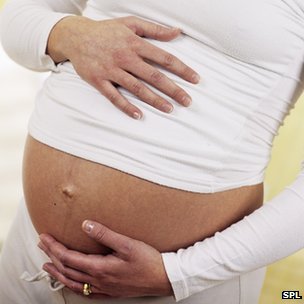Pregnant women aged over 40 should be given the option of being induced early to reduce the risks of losing their baby, says a Royal College of Obstetricians and Gynaecologists paper.

Inducing these women at 39 weeks instead of the normal 41 could prevent 17 stillbirths in the UK each year, the authors said.
And this would not lead to increased numbers of caesarean sections.
A stillbirth charity said induction could save many babies’ lives.
Dr Mandish Dhanjal, a clinical senior lecturer from Imperial College Healthcare NHS Trust, and Dr Anna Kenyon, from University College London Hospital, looked at a number of studies that explored the impact of the rising age of mothers on the health of the foetus and the mother.
Good argument
The data showed that at 39-40 weeks pregnant, women over 40 double their risk of stillbirth compared with women under 35 – two in 1,000 compared with one in 1,000.
But at 39 weeks, the risk is lowered for the older group – becoming similar to women in their late 20s at 41 weeks pregnant.
As a result, Dr Kenyon said, there was a good case for inducing labour early.
“It is justifiable for experts to conclude that inducing labour at an earlier stage of gestation (39-40 weeks) in older mothers (40+ years) could prevent late stillbirth and any maternal risks of an ongoing pregnancy, without increasing the number of operative vaginal deliveries or emergency caesarean sections.”
She added that further research was required to find out how induction affects pregnant women “of advanced maternal age”.
The authors calculated that an extra 550 women would have to be induced at 39 weeks in the UK each year to prevent one stillbirth.
Inducing at 40 weeks could prevent seven stillbirths a year, if an extra 4,750 women were induced, they said.
Complications
Statistics show that between 1997 and 2008 the proportion of pregnant women in the UK that are aged 35 and over increased from 8% to 20%, and that of women aged 40 and over rose from 1.2% to 3.6%.
In their paper, the authors said there was a proven link between advancing maternal age and increased risk of complications during pregnancy – and a strong link with increased risk of stillbirth and neonatal death.
For women over 40 in the UK, the rate of unexplained stillbirths – defined as losing a baby after 24 weeks of pregnancy – is 7.6 per 1,000 pregnancies compared with 5.5 in women aged 35-39.
In women aged 30-34, it is 4.7. And for 25-29-year-olds, the rate is 4.6.
This equates to an absolute risk of one in 132 for the over-40s and one in 182 for 35-39-year-old women.
Research published in the Lancet in 2011 indicated that the UK had higher stillbirth rates than almost every other high-income country.
Charlotte Bevan, from the stillbirth and neonatal death charity Sands, said hundreds of stillbirths were potentially avoidable.
“It is with enormous frustration and sadness that Sands too often hears from mums whose seemingly perfect baby dies at or beyond term.
“Sometimes it’s a first baby, in some cases it’s an IVF pregnancy and because of her age, that bereaved mum may not now go onto to have any more children.
“The offer of induction at term for older mums could save many families from the indescribable devastation of losing a precious child.”





